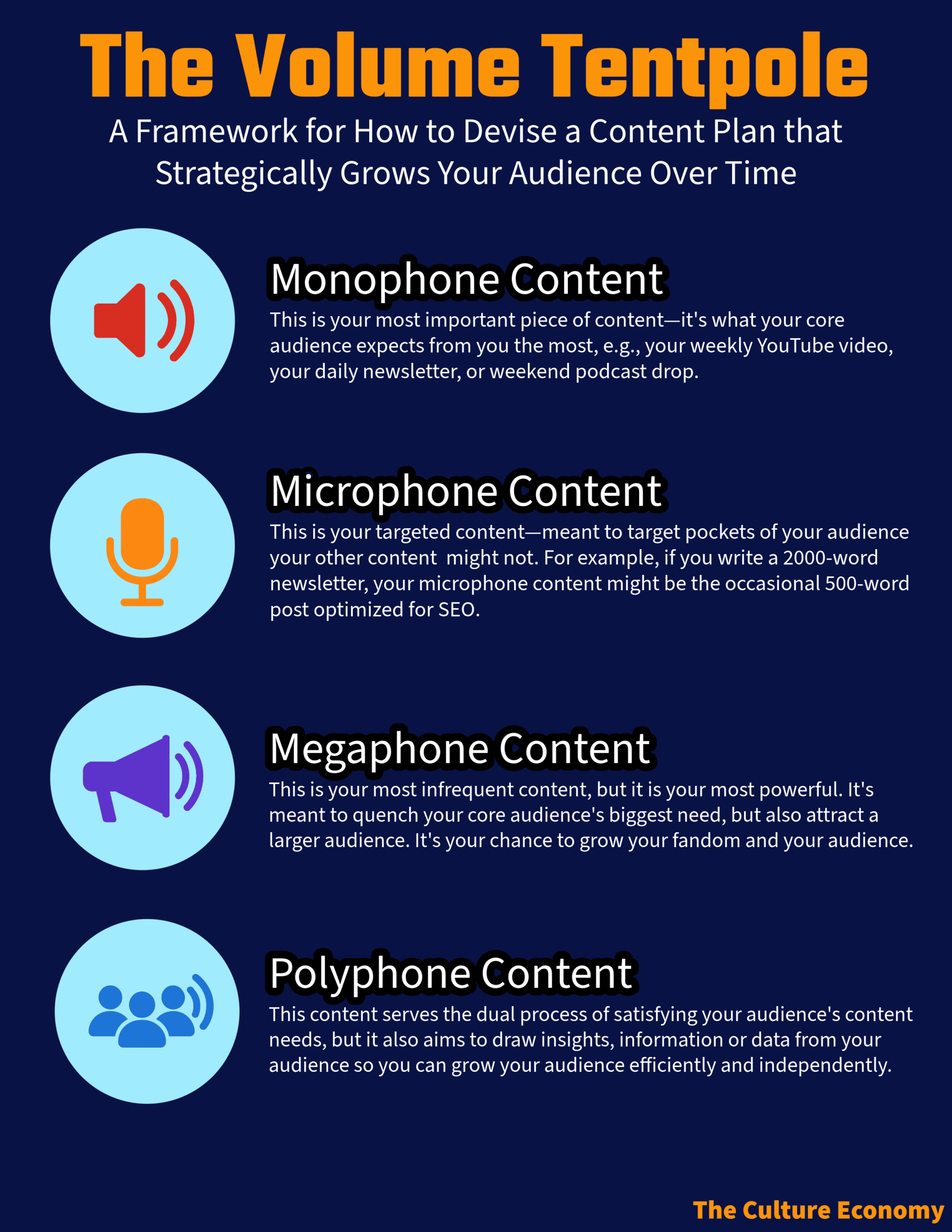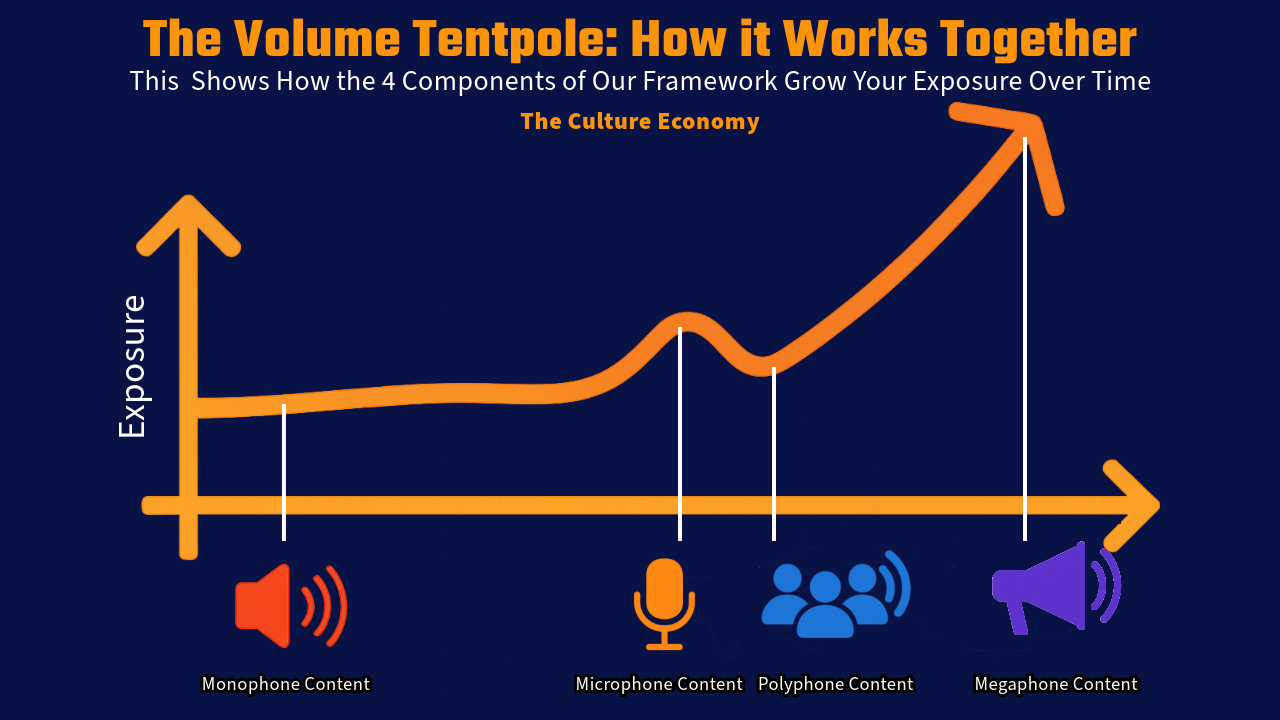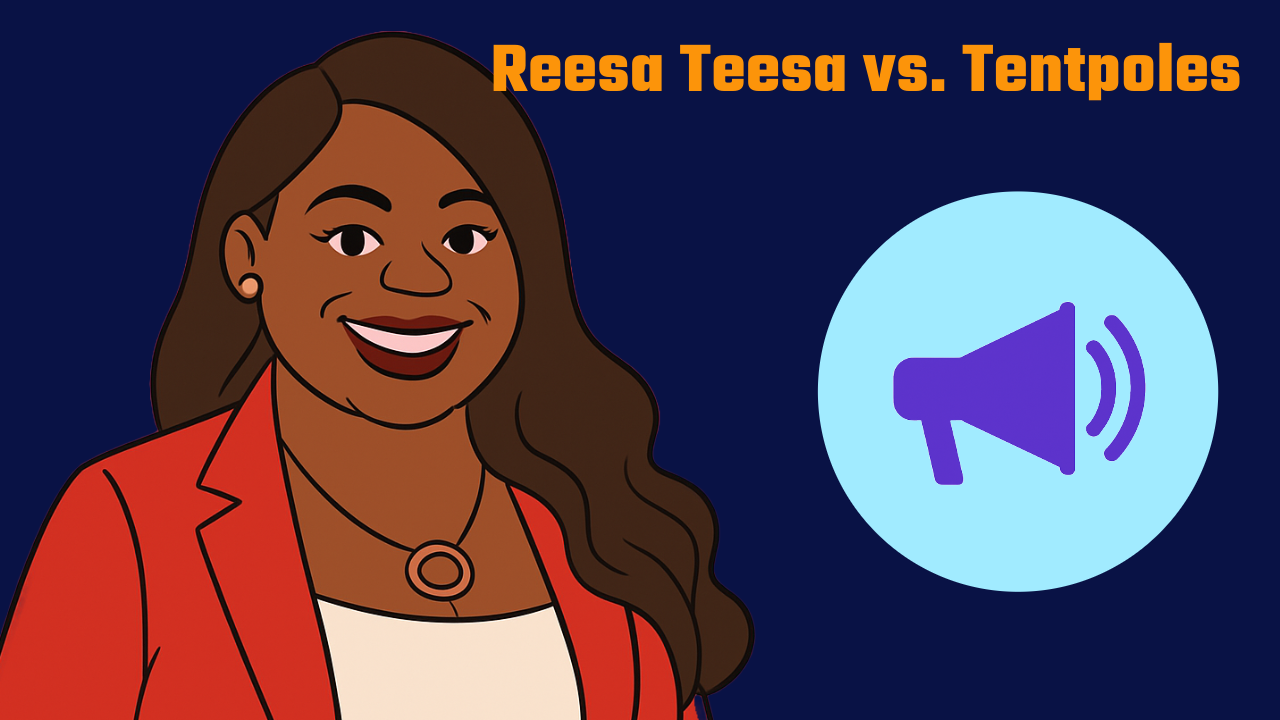Tentpole Strategy, Vol. 2
This week, we finally crossed the 100-subscriber mark. Honestly, I was hoping to have surpassed this milestone long ago, even before I launched. I had all types of “growth hacks” I wanted to deploy but haven’t gotten to, as I’ve been so focused on the content.
But it feels good to get here 100% organically. Everyone here typed their own email address into a white text box on my site. So to know 100 people have done that, with 65% of you reading every week, is certainly something I’m happy to see and encourages me to keep going!
Now, let’s get this started!
Our discussion on virality has officially dovetailed.
Our first several editions dived right into virality:
- The magic and randomness of it.
- Its fading cultural and fiscal impact.
- How it’s not so great for ALL creators.
And last week, we began the discussion on tentpoles:
- What are they?
- What do they consist of?
- Why are they successful?
Today, we continue the tentpole conversation by diving into how to create a tentpole of your own. And if you know me, I’ll use no shortage of words to offer up all of the strategic ways you should think about creating a tentpole for your creator business.
Internal vs. External Tentpoles
Last week we talked about Beyonce’s Lemonade, which is what we’d call an internal tentpole, as opposed to another type; the external tentpole.
Internal Tentpoles: Events created from scratch:
- Examples: Series premieres, launches, hosted events
- Pros: Total control, ownable IP, repeatable
- Cons: No built-in interest, more marketing required, more work
External Tentpoles: Built around pre-existing events
- Examples: BHM events, holiday tie-ins, Oscars watch party
- Pros: Built-in momentum/interest, organic discovery, proven models
- Cons: Crowded, less control, short-lived, IP-dependent
I probably don’t need to go into these too much, as their differences, pros, and cons are pretty self-explanatory. That said, I will give you my thoughts on how you should determine which type of tentpole you should be focused on:
When to focus on an Internal Tentpole:
- You’re only going to do one tentpole a year
- You have a massive audience that’s heavily engaged
- There are no established external events in your niche
When to focus on an External Tentpole:
- You can’t afford a modest version of the internal event you want
- There’s an obvious external event you have to make content for (e.g., you’re a toy channel and Christmas is coming)
- You don’t have a significant audience yet
Strategically, if you can, aim to do at least one internal tentpole and one external tentpole per year. But that begs the question…
How Many Tentpole Events Should I Do?
The primary answer to this is no more than you have time for.
As I mentioned last week, there are certain things you need to establish with your content and as a creator before you can truly reap the benefits of a tentpole event. Most importantly, you need to (1) make sure there’s a clear purpose for your tentpole, (2) you’ve established an audience through consistent posting, and (3) that you have a way to get the word out about your tentpole event.
If you aren’t doing those things, then the answer to how many tentpoles you should do is zero.
But if you can do all of those things while planning a tentpole, then I’ve set some guidelines based on my own observations:
Early Stage Creators:
- Start with 2 tentpoles a year.
- One external. One internal.
- Make sure they’re repeatable.
Mid-stage Creators with a Rhythm:
- Aim for 3-4 tentpoles per year.
- Quarterly is probably best, and aligns with brands’ quarterly goals.
- Use each tentpole to build momentum for the next.
Established Creators with teams or systems:
- Go for 6 tentpoles per year.
- They don’t all have to be huge.
- Use smaller ones to reach your truest fans.
- Test and experiment. You don’t have to repeat all 6 annually.
Above all else though: go for quality over quantity.
Yes, I’m pushing you to do what you can, but don’t confuse that with allowing the value you’re bringing to your audience to suffer.
Remember, these should be your showcases for the year!
Think of tentpoles like TV season premieres, mid-season finales, and finales. You should look back on your tentpoles and say those were the best and most wide-ranging events (“episodes”) I did as a creator this past year.
More importantly, your fans should be saying that about them, too.
Reesa Teesa: The Counterfactual Case Study
Reesa Teesa absolutely captured the zeitgeist last year. I didn’t watch all 500 minutes, but her saga clearly resonated. It’s going to be a TV show one day!
That said…
When it comes to tentpoles, Reesa Teesa did it absolutely, positively, undoubtedly…wrong?!?!?!
Don’t get me wrong, it all worked out for her. And what she has learned in her relatively short time as a creator outdoes everything I’ve done and learned from being in this “industry” for the better part of the last 20 years, having started off as an OG blogger.
But my issue—such that it is—is that Reesa did things backwards. She launched with a tentpole instead of building towards one. It worked out because…
- She kicked off her TikTok page with a clear purpose to tell her story
- She used top-tier storytelling that resonated with millions
- She used earned media to become THE cultural moment of 2024
However, what she didn’t do was:
- Have a library of content that people could watch once hooked
- Have a monetization plan to generate revenue from all of that attention
- Have a clear call-to-action
- Have a follow-up content strategy in place
- Have a way to own some of her audience
Thus, while she may have had the most consequential, platform-endemic, tentpole series of our time, it was poorly done in terms of strategy and execution.
Now, in her defense, she probably didn’t know her story was going to be that huge from the start. Still, she knew she was telling one heck of a story, and if she had been thinking about it like a businessperson, instead of, perhaps, relying on it going viral, she may have approached things differently.
So, with the advantage of hindsight, here are the steps she should’ve taken if she had been designing the perfect tentpole:
- Established Early Content & Momentum: She was sitting on story gold, so she didn’t need to waste too much time with less exciting content. But instead of kicking things off with her magnum opus, she should’ve led with at least 90 days of posting 3 times a week, telling stories about her life—maybe even teasing the real story along the way. With Reesa’s talents, she can make anything sound interesting, and those stories would’ve been worthy of a user’s time. This would’ve allowed her to establish a relationship with early fans, and it would’ve made for a great library of content for people to turn to once her feature story hooked millions.
- Launched a YouTube Channel Earlier: I’m not saying I would’ve done anything special on YouTube, but because she posted 10-minute videos, there was a massive opportunity for her to do well, viewership-wise and financially, on YouTube’s long-form-friendly platform. And it’s a better place to build a meaningful community.
- Monetize & Bonus Content: A week or so into her going viral, I would’ve added a link where people could immediately get the full story by paying for it. This would’ve unlocked some real dollars for her, especially if she did it at a premium price. She was such a case study in media that plenty of people with business credit cards would’ve paid a whole lot to get advanced notice, a transcript, or whatever other bonus details she could provide. And if brand deals weren’t flowing her way yet, she could have leveraged affiliate links to products that tied into her story. Additionally, I would’ve created “after show” content, where after each episode, folks could do a live Q&A. It could be free or paid. Of course, these methods would also allow me to collect email addresses.
- Leverage the Press More: Reesa did a great job of leveraging the press. She was on Tamron Hall, Good Morning America, and featured in The Cut. But there was so much more to be done. I would’ve loved for her to have more of a “call to action” during her interviews, even if it was just “Subscribe to my new YouTube channel”. I also don’t think she did enough creator-on-creator engagement. There probably wasn’t a creator in the world who would’ve turned her down. She could’ve done hundreds of interviews with YouTubers and podcasters—not just traditional media. And it also would’ve been a great time to establish a strategic relationship with a specific cause, like an abuse prevention organization, for example. It would’ve “forever” associated her with a mission and brought her regular and organic exposure in a very positive way.
- Have A Follow-Up Series: Whether it was a new series, a new format, or a new collaboration, Reesa should have had something very specific, story-aligned, and programmed for after the saga was over. Currently, we’re not seeing a whole lot out of her outside of some random posts and brand collabs. It seems we’re just left waiting for her TV show to be developed, which may be years from now. That’s a lot of lost momentum!
That’s the strategic playbook Reesa could’ve employed to take full advantage of her massive viral moment. Sure, her impeccable storytelling skills allowed her to find success on her own terms. But don’t be fooled. For most of us, who either don’t have her skills or are unlikely to see that kind of virality, I just want to use her as an example of how you can be even more strategic about building your own tentpole strategy.
The Tentpole Framework
In talking about tentpoles, we’ve discussed why they’re important, the different types, and how to execute them—or at least how to re-execute Reesa’s!
What we haven’t necessarily talked about is why they work.
The best way to illustrate this is with my framework: The Volume Tentpole.
During my time at YouTube, we were taught the Hero-Hub-Help content model. It’s genius in that it outlines a clear strategy for how folks can grow on YouTube, and really, in all mediums.
But that model leaves out the one element to building your creator business that I think is most important—and if I’m being honest, it’s the part that doesn’t serve YouTube, or any platform’s, best interest.
The Volume Tentpole framework adds this element in, and it works like this:
- Monophone Content: This is your most consistent and earnest content. If we’re talking about a YouTube channel, we’re talking about your weekly, 8-10 minute, formatted series that your viewers love you for. This content is a magnet for your truest fans.
- Microphone Content: This is targeted, but generally low-level content, that allows you to acquire new users in specific ways. For example, if you have a weekly newsletter that puts out 2,000 words every edition, you might occasionally choose to write shorter 500-word entries that target common SEO queries for your niche. If you’re a podcaster, this may be subject-themed clips you turn into Shorts.
- Megaphone Content: These are your tentpoles, your high-impact, breakthrough moments meant to reach your hardcore fans, people generally interested in your space, and hopefully, people who would never otherwise consume your content.
Those 3 types of content, for the most part, are analogous to YouTube’s original framework, with some adjustments, and they help you continuously build and strengthen your audience. However, here’s the fourth, and perhaps most important, content type:
- Polyphone Content: This is content that serves 2 purposes. One is to serve the content needs of your audience. And two, it should acquire insights, information, or data from your audience, allowing you to grow your audience beyond your core platform. This may include AMAs, live forums, office hours, or even meetups.
Polyphone content is the layer where your viewers transfer from an audience to a community. It’s where you use the intrigue, excitement, and anticipation of content to move out of a reliance on major platforms and into a community that moves with you.

Of course, polyphone content can overlap with the other forms. Certainly, your megaphone content (tentpoles) can involve people interacting in real life or virtually. And if your weekly series content (your monophone layer) is you live streaming while answering questions from your viewers, that too can lock people into a community.
But it’s important that polyphone content also lives outside the other 3 layers, as that is where you’re likely to earn and retain the most die-hard fans. So in creating this format, figure out something you can do monthly that involves creating content and/or moments in conjunction with your fans, allowing you to gain the insights and information you need to grow both on and off your primary platform.

Real Results of Creators Using Tentpoles
Okay, I’ve been promising a positive reflection on endemic creators using tentpoles well, and I will finally deliver on it. Here are 3 creators that I’ve noticed executing tentpoles, and parts of the Volume Tentpole framework, with tremendous success.
Kountry Wayne: Wayne built his empire on his monophone content: consistent, scripted skits rooted in faith, family, and humor. His microphone layer consists of memeable characters, punchline shorts, and personable moments that often go viral without wasting time chasing trends. His most notable tentpole (i.e., megaphone content) is his Netflix special, which also consisted of a national comedy tour, with in-person meetups that served as his polyphone layer.
Tabitha Brown: Tabitha has had multiple monophone offerings—vegan recipes, affirmation videos, and “hello there” videos—all of which consistently delivered on an emotional and aspirational experience. She has experimented well with microphone content, including reaction videos, playful catchphrases, and attempts at viral TikToks. Her notable megaphones have been “Tab Time” (a YouTube series for kids), as well as content around her various product launches.
Terrell Grice: “The Terrell Show” is clearly Grice’s monophone content, as his personality-driven interviews are at the heart of what his viewers love. His microphone content consists of the most extreme characterizations of that personality via outtakes, interview clips, and fan-made remixes that travel well in short-form video. Like a great producer, he leverages his existing show for megaphone events, making season premieres, live shows, and special episodes must-see-TV. And on Instagram and YouTube, Grice is consistently using polls (polyphone content) to figure out what his fans want to create a real audience-driven feedback loop.
Why Tentpoles Work Better for Black Creators
Now you may be asking, “Why write this with black creators in mind? Isn’t this applicable to everyone?”
Yes, it is applicable to everyone.
But it’s imperative to Black creators.
- Unlike virality, which is harder to come by for Black creators, tentpoles are planned, not random.
- Unlike virality, tentpoles build long-term brand and equity—something Black creators are often short-changed on.
- Unlike virality, tentpoles assure your biggest moments can’t be stolen, like many Black-created trends have been.
- Unlike virality, tentpoles can have clear monetization, something Black creators systematically get less of.
So yes, every creator should be focused on tentpoles—they’re the far more strategic, intentional, and monetizable path. But because of systemic issues built into the creator economy, for 99% of Black creators, tentpoles are the most viable path to building wealth and culture on their own terms.
So, Where Do You Get Started?
Technically, you have all of the information you need. But if you want to boil it down to a few questions, ask yourself these:
- What’s the moment you’re planning toward, around, or for?
- What will make people care about your tentpole?
- How will people find out about your tentpole?
- What is your audience most likely to pay for?
- What’s your content plan for post-tentpole?
If you want more help, you can use my Tentpole Builder. It will guide you through all the questions you need to answer as you plan out your tentpole event!
Wrapping Up
So that’s the end of my focus on tentpoles within the context of virality. Next week, we’ll wrap up the entire Virality Paradox series by answering the question:
What is the future of virality for Black creators?
